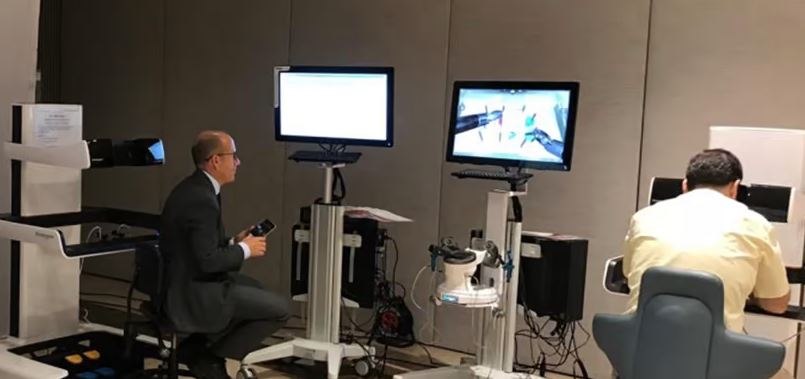Customer Company Size
Large Corporate
Region
- Africa
Product
- SimpliVity OmniCube
Tech Stack
- Oracle
- Microsoft Exchange
- Microsoft SQL Server
- Microsoft SharePoint
- SAP
Implementation Scale
- Enterprise-wide Deployment
Impact Metrics
- Cost Savings
- Productivity Improvements
Technology Category
- Infrastructure as a Service (IaaS) - Cloud Computing
Applicable Industries
- Education
Applicable Functions
- Discrete Manufacturing
Services
- Cloud Planning, Design & Implementation Services
About The Customer
The University of Namibia (UNAM) is a national university located in Namibia, Africa. As an educational institution, UNAM relies heavily on various applications for its operations, including Oracle, Microsoft Exchange, Microsoft SQL Server, Microsoft SharePoint, SAP, VDI, and a host of academic applications. The university was looking to modernize its infrastructure and consolidate its data center. They were also interested in implementing Virtual Desktop Infrastructure (VDI) and supporting Tier-1 applications. The university was seeking a solution that could handle their current requirements and accommodate potential future growth.
The Challenge
The University of Namibia (UNAM) was looking to refresh their entire legacy infrastructure and simplify the management and maintenance of their systems. They were facing challenges with data center consolidation, infrastructure modernization, Virtual Desktop Infrastructure (VDI), supporting Tier-1 applications, and virtualizing their physical infrastructure. They approached Salt Essential IT, a value-added reseller of SimpliVity, for advice on available VDI solutions. After several meetings and a Proof of Concept (POC) on Pivot3, a tender was offered for Pivot3. However, SimpliVity's OmniCube had become available and was presented as a potential solution.
The Solution
UNAM chose SimpliVity's OmniCube over incumbent legacy providers and VDI-specific solutions such as HP, IBM servers and storage, and Pivot3. The OmniCube was able to deliver a solution to support UNAM’s current VDI requirements and provide features that were not available by any other vendor in a single, easy-to-manage, scalable package. The built-in features such as backup and DR or inline deduplication, compression, and optimization were particularly appealing. SimpliVity supplied the University of Namibia with two OmniCube CN-3000s to replace their legacy systems that were point solutions specifically for VDI implementation. The University, after experiencing SimpliVity’s OmniCube, is now also interested in using it for their overall virtual infrastructure environment as well as at their northern campus and nationwide campus.
Operational Impact
Quantitative Benefit

Case Study missing?
Start adding your own!
Register with your work email and create a new case study profile for your business.
Related Case Studies.

Case Study
Revolutionizing Medical Training in India: GSL Smart Lab and the LAP Mentor
The GSL SMART Lab, a collective effort of the GSL College of Medicine and the GSL College of Nursing and Health Science, was facing a challenge in providing superior training to healthcare professionals. As clinical medicine was becoming more focused on patient safety and quality of care, the need for medical simulation to bridge the educational gap between the classroom and the clinical environment was becoming increasingly apparent. Dr. Sandeep Ganni, the director of the GSL SMART Lab, envisioned a world-class surgical and medical training center where physicians and healthcare professionals could learn skills through simulation training. He was looking for different simulators for different specialties to provide both basic and advanced simulation training. For laparoscopic surgery, he was interested in a high fidelity simulator that could provide basic surgical and suturing skills training for international accreditation as well as specific hands-on training in complex laparoscopic procedures for practicing physicians in India.

Case Study
IoT platform Enables Safety Solutions for U.S. School Districts
Designed to alert drivers when schoolchildren are present, especially in low-visibility conditions, school-zone flasher signals are typically updated manually at each school. The switching is based on the school calendar and manually changed when an unexpected early dismissal occurs, as in the case of a weather-event altering the normal schedule. The process to reprogram the flashers requires a significant effort by school district personnel to implement due to the large number of warning flashers installed across an entire school district.

Case Study
Implementing Robotic Surgery Training Simulator for Enhanced Surgical Proficiency
Fundacio Puigvert, a leading European medical center specializing in Urology, Nephrology, and Andrology, faced a significant challenge in training its surgical residents. The institution recognized the need for a more standardized and comprehensive training curriculum, particularly in the area of robotic surgery. The challenge was underscored by two independent studies showing that less than 5% of residents in Italian and German residency programs could perform major or complex procedures by the end of their residency. The institution sought to establish a virtual reality simulation lab that would include endourological, laparoscopic, and robotic platforms. However, they needed a simulator that could replicate both the hardware and software of the robotic Da Vinci console used in the operating room, without being connected to the actual physical console. They also required a system that could provide both basic and advanced simulation training, and a metrics system to assess the proficiency of the trainees before they performed surgical procedures in the operating theater.

Case Study
Edinburgh Napier University streamlines long-distance learning with Cisco WebEX
• Geographically dispersed campus made in-person meetings costly and inconvenient.• Distance-learning programs in Malaysia, India, and China required dependable, user-friendly online tools to maximize interaction in collaborative workspaces.• Virtual learning environment required a separate sign-in process, resulting in a significant administrative burden for IT staff and limited adoption of collaboration technology.

Case Study
8x increased productivity with VKS
Before VKS, a teacher would spend a lot of time showing a group of 22 students how to build a set of stairs within a semester of 120 hours. Along with not leaving the teacher much time to provide one-on-one support for each student to properly learn carpentry, it also left a considerable amount of room for error. Key information would be misinterpreted or lost as the class was taught in the typical show-and-tell way.

Case Study
Scalable IoT Empowering GreenFlex's Sustainable Growth
GreenFlex, a company that supports sustainable development, decarbonization, and energy efficiency, faced several challenges in its quest to expand its business. The company needed to deploy a robust and sustainable IoT technology to support its growth. It was crucial for them to monitor and control devices at customer sites in a safe and reliable manner. They also needed to integrate devices across a range of communication protocols and gather and act on data to meet efficiency targets. GreenFlex had previously built IoT capabilities into its digital platform, GreenFlexIQ, to monitor and manage customer sites remotely. However, they soon realized that they needed a new platform to support their ambitions. They needed a platform that could scale to connect more devices for production management and make it easier for the operations team to manage devices in the field.




---nyse--hpe_1.jpg)


